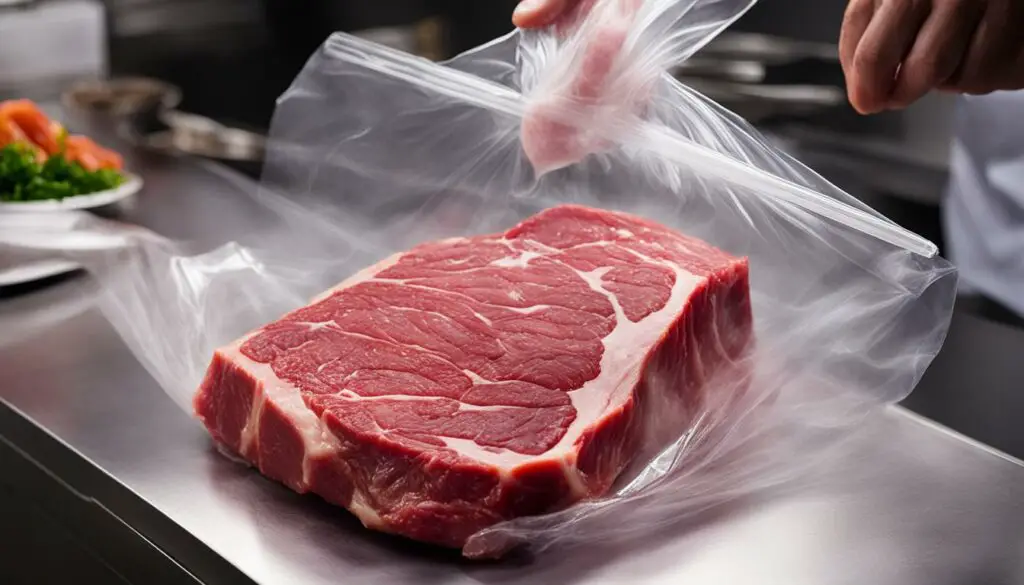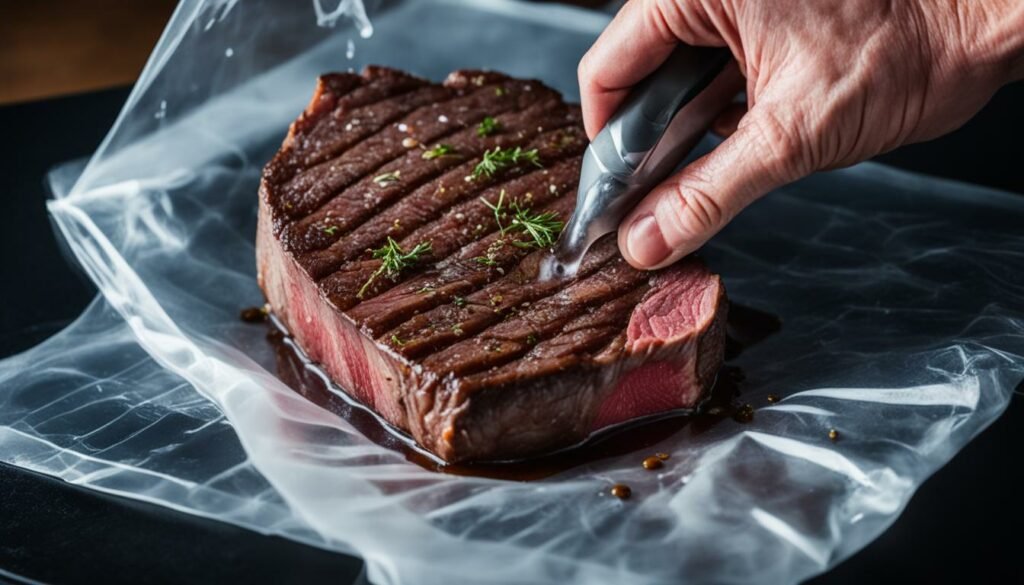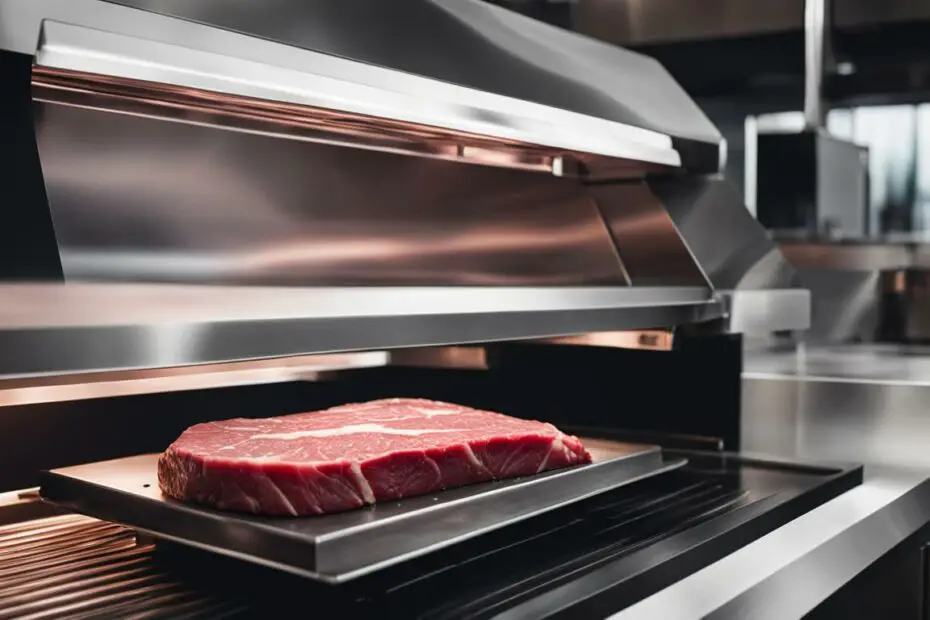Imagine this: It’s a special occasion, and you’ve decided to treat yourself to a mouthwatering, perfectly dry aged steak. The anticipation builds as you prepare your ingredients and set the stage for a culinary masterpiece. But as any steak connoisseur knows, achieving that melt-in-your-mouth perfection is no easy feat.
That’s where vacuum sealing comes into the picture. By using a high-quality vacuum sealer designed specifically for dry aging steak, you can take your culinary skills to the next level and unlock a world of flavor and tenderness.
So, let’s dive into the benefits of vacuum sealing for dry aged steak and learn how to achieve unparalleled results in the comfort of your own kitchen.
Every time you sink your teeth into a succulent dry aged steak, you’re experiencing the result of a carefully controlled process. Dry aging involves aging meat in a controlled environment to enhance its flavor, tenderness, and richness. But did you know that vacuum sealing can further elevate the quality of the meat and ensure optimal results?
With a vacuum sealer designed specifically for dry aging, you can seal your precious cuts of meat in an airtight environment, locking in the natural juices and intensifying the flavor. No more worry about oxidation or spoilage—just a juicy, tender steak that will surpass even your highest expectations.
Discover the best vacuum sealer for dry aging steak and learn how this essential tool can help you achieve restaurant-quality results at home. Get ready to amaze yourself and your guests with the most incredible dry aged steaks you’ve ever savored.
Understanding the Dry Aging Process and Its Benefits
Understanding the dry aging process is essential to achieving the perfect dry aged steak. Dry aging is a technique that involves hanging meat in a controlled environment with specific temperature and humidity conditions. This process allows the natural enzymes in the meat to break down muscle fibers, resulting in increased tenderness and flavor development.
What Is Dry Aging?
Dry aging is a traditional method of aging meat that enhances its taste and texture. During the dry aging process, whole cuts of beef are left to mature in carefully controlled conditions. The meat is typically stored in a refrigerated room or cabinet with precise temperature and humidity levels. This aging process can range from several weeks to several months, depending on the desired flavor intensity.
Dry Aged vs. Wet Aged Steak
When it comes to aging steak, there are two main methods: dry aging and wet aging. Dry aged steak is the traditional method, while wet aged steak is a more modern approach.
Dry aged steak is hung in a controlled environment, allowing it to naturally tenderize and develop a unique flavor profile. The process involves exposing the meat to air, which enables moisture to evaporate from the surface, resulting in concentrated flavor. Dry aged steak has a distinct taste, with a pronounced nutty, buttery, and earthy flavor.
On the other hand, wet aged steak is vacuum-sealed and stored in plastic bags. This method retains moisture and prevents the meat from losing weight during the aging process. While wet aged steak can still develop tenderness, it may lack the intense flavor and concentrated taste of its dry aged counterpart.
Benefits of Vacuum Sealing Dry Aged Steak
Vacuum sealing dry aged steak offers several benefits that enhance the overall quality and taste of the meat. Here are some advantages of using vacuum sealing during the dry aging process:
- Flavor Enhancement: Vacuum sealing helps to lock in the natural juices of the meat, intensifying the flavor and resulting in a more succulent and flavorful steak.
- Moisture Retention: Vacuum-sealed dry aged steak retains its moisture, resulting in a juicier and more tender final product.
- Reduced Trimming: Vacuum sealing eliminates the need for excessive trimming, as the meat retains its moisture and does not require excessive fat removal.
- Extended Shelf Life: Vacuum-sealed dry aged steak has a longer shelf life compared to non-vacuum-sealed meat, as it is protected from spoilage and oxidation.
Vacuum sealing is a valuable technique in the dry aging process that ensures optimal flavor, tenderness, and preservation of the steak.
Selecting the Best Vacuum Sealer for Dry Aging Steak
Choosing the right vacuum sealer for dry aging steak is crucial for achieving optimal results. When selecting a vacuum sealer, there are several factors you should consider:
- Sealing capabilities: Look for a vacuum sealer that has a strong sealing power and can effectively remove air from the bags. This ensures a tight seal and helps preserve the flavor and tenderness of the meat.
- Durability: A vacuum sealer for dry aging steak should be durable enough to withstand the extended periods of use required for the aging process. It should be able to handle the demands of sealing multiple steaks over time.
- Compatibility with dry aging bags: Ensure that the vacuum sealer you choose is compatible with the specific dry aging bags you plan to use. This ensures a proper seal and prevents air leakage during the aging process.
To find the best vacuum sealer for dry aging steak, it’s recommended to research and compare different options available on the market. Look for customer reviews and ratings to gain insights into the performance and reliability of each vacuum sealer. Consider your specific needs and budget when making a decision.
Step-by-Step Guide to Dry Aging Steak at Home
Choosing the Right Cut
When it comes to dry aging steak, selecting the right cut is essential for achieving the best results. Choose cuts of meat with sufficient marbling, such as ribeye, striploin, or T-bone steaks. The marbling, or small streaks of fat within the muscle, adds flavor and tenderness to the steak during the aging process. Opt for prime or choice graded cuts for superior quality.
Preparation of the Meat
Prior to dry aging, it’s important to properly prepare the meat. Start by trimming off any excess fat and silver skin from the steak. This allows for better air circulation and prevents the development of off-flavors. Season the steak with a generous amount of salt to enhance its flavor during the aging process. Place the steak on a wire rack set over a tray or plate to allow air to circulate around the meat.
Sealing the Meat for Aging
To ensure an optimal dry aging process, it’s crucial to properly seal the meat. Place the seasoned steak inside a vacuum-sealed bag or use a food-grade plastic wrap, ensuring it is tightly wrapped around the meat to prevent air contact. For added protection, you can double wrap the steak. A vacuum-sealed bag provides a more efficient seal by removing excess air and creating an airtight environment for the aging process.
Refrigeration Requirements and Tips
Once the steak is sealed, it’s time to place it in the refrigerator for dry aging. Set the refrigerator temperature to a range between 34°F to 38°F (1°C to 3°C). This temperature range slows down bacterial growth while allowing natural enzymes to break down the muscle fibers and tenderize the meat. Ensure the refrigerator has a consistent humidity level of around 75% to prevent excessive drying of the steak. Avoid placing other strong-smelling foods or ingredients near the aging steak, as it can absorb unwanted flavors. For optimal results, allow the meat to age for a minimum of 21 days, though longer periods may result in more intense flavors and tenderness.
| Step | Instructions |
|---|---|
| 1 | Choose the right cut of meat with sufficient marbling. |
| 2 | Trim excess fat and silver skin from the steak. |
| 3 | Season the steak with salt. |
| 4 | Place the steak on a wire rack over a tray or plate. |
| 5 | Seal the steak tightly using a vacuum-sealed bag or plastic wrap. |
| 6 | Set the refrigerator to a temperature between 34°F to 38°F (1°C to 3°C). |
| 7 | Maintain a humidity level of around 75% in the refrigerator. |
| 8 | Age the steak for a minimum of 21 days. |
Vacuum Seal for Dry Aging Steak: The Essential Tool
A vacuum sealer is an essential tool for dry aging steak. It helps create a tight seal around the meat, removing excess air and preventing oxidation. By vacuum sealing the meat, you can achieve a more concentrated flavor and enhance the tenderness of the steak. The vacuum sealer ensures that the meat retains its natural juices, resulting in a juicier and more flavorful final product. Investing in a high-quality vacuum sealer specifically designed for dry aging steak is crucial for achieving the best results.

The Importance of Consistent Temperature and Humidity
Maintaining consistent temperature and humidity levels is crucial for successfully dry aging steak. The optimal temperature range for dry aging steak is between 34°F to 38°F (1°C to 3°C). This temperature range helps slow down the growth of bacteria while allowing the natural enzymes to tenderize the meat. Humidity levels should be kept around 75% to prevent the meat from drying out excessively. Fluctuations in temperature and humidity can lead to spoilage or uneven aging, affecting the quality of the final product.
“Consistent temperature and humidity are key factors in the dry aging process. They create the ideal environment for the meat to develop its unique flavors and textures.”
Using a dedicated refrigerator or dry aging cabinet with precise temperature and humidity controls can help ensure the desired environment for dry aging steak. These specialized appliances are designed to maintain consistent conditions throughout the aging process, allowing you to achieve the best possible results. By controlling the temperature and humidity, you can ensure that the meat ages evenly and develops the desired flavor profile.
| Temperature Range | Humidity Level |
|---|---|
| 34°F to 38°F (1°C to 3°C) | Around 75% |
Troubleshooting Common Issues During Dry Aging
Dealing with Moisture and Air Pockets
During the dry aging process, it’s important to keep moisture under control and prevent air pockets from forming in the dry aging bag. Excessive moisture can lead to spoilage, while air pockets can hinder the proper aging of the steak. Here are a few tips to address these issues:
- Ensure the dry aging bag is properly sealed to minimize air pockets. Check for any gaps or loose seals and reseal if necessary (see section on “When to Reseal Your Dry Aging Bag” below).
- Monitor the humidity levels in the aging environment. Use a hygrometer to measure humidity and adjust as needed. If the humidity is too high, consider using drying agents like rice or activated charcoal in the aging chamber to absorb excess moisture.
- Inspect the dry aging bag for any signs of condensation or excessive moisture buildup. If moisture is present, carefully dry the interior of the bag using a clean cloth or paper towel.
When to Reseal Your Dry Aging Bag
Periodically checking and resealing your dry aging bag is essential to maintain a proper aging environment and prevent spoilage. Here are some signs that indicate it’s time to reseal your dry aging bag:
- Visible air pockets or gaps in the bag seal
- Inadequate adhesion of the bag to the meat
- Continued moisture accumulation in the bag despite efforts to control humidity
Resealing the bag ensures a tight seal, eliminates air pockets, and helps maintain an optimal aging environment for the steak.
How to Recognize Spoilage
It’s important to be able to identify spoilage in dry aged steak to prevent consuming potentially harmful meat. Here are some signs that indicate spoilage:
- Unpleasant odor: If the steak emits a foul or rancid smell, it is likely spoiled.
- Discoloration: Look for any significant changes in color, such as green or black spots, indicating bacterial growth.
- Mold growth: Visible mold on the surface of the steak signifies spoilage and should be discarded.
- Slime or slimy texture: Any slimy or sticky residue on the meat is a clear indication of spoilage.
If you observe any of these signs, it’s best to err on the side of caution and discard the spoiled steak.

Conclusion
In conclusion, using a vacuum sealer for dry aging steak is a game-changer in achieving restaurant-quality results right in your own kitchen. By understanding the dry aging process, selecting the best vacuum sealer, and following a step-by-step guide, you can enjoy the perfect dry aged steak with enhanced flavor, tenderness, and richness.
One of the key benefits of using a vacuum sealer is the ability to lock in the natural juices of the meat, resulting in a more succulent and flavorful steak. Vacuum sealing also eliminates the need for excessive trimming, as the meat retains its moisture and doesn’t require additional fat removal. This means more meat to enjoy and less waste!
Remember, maintaining consistent temperature and humidity levels is crucial for successful dry aging. Investing in a vacuum sealer specifically designed for dry aging steak is essential, as it ensures a tight seal and removes excess air from the bags. With the right techniques, tools, and a little troubleshooting, you can elevate your culinary experience and indulge in the perfect dry aged steak every time.
FAQ
What is dry aging?
Dry aging is a process that involves aging meat in a controlled environment to enhance its flavor, tenderness, and richness.
What is the difference between dry aged and wet aged steak?
Dry aged steak is aged in a controlled environment with specific temperature and humidity conditions, while wet aged steak is aged in vacuum-sealed bags.
What are the benefits of vacuum sealing dry aged steak?
Vacuum sealing helps lock in the natural juices of the meat, intensifying the flavor and preventing spoilage. It also eliminates the need for excessive trimming, as the meat retains its moisture.
What is the best vacuum sealer for dry aging steak?
The best vacuum sealer for dry aging steak is one that has strong sealing capabilities, durability, and compatibility with dry aging bags.
How do I dry age steak at home?
To dry age steak at home, you need to choose the right cut, prepare the meat, seal it for aging, and maintain consistent temperature and humidity levels in a dedicated refrigerator or dry aging cabinet.
Why is a vacuum sealer essential for dry aging steak?
A vacuum sealer creates a tight seal around the meat, removing excess air and preventing oxidation. It helps retain the natural juices of the meat, resulting in a juicier and more flavorful final product.
Why is consistent temperature and humidity important for dry aging steak?
Consistent temperature and humidity levels are crucial for successful dry aging. The optimal range is between 34°F to 38°F (1°C to 3°C) and 75% humidity to prevent spoilage and ensure proper aging.
What are common issues that may arise during the dry aging process?
Common issues during the dry aging process include dealing with moisture and air pockets in the dry aging bag, knowing when to reseal the bag, and recognizing spoilage in the steak.
Note: The FAQ section should be formatted with the appropriate HTML tags in your final publication.
